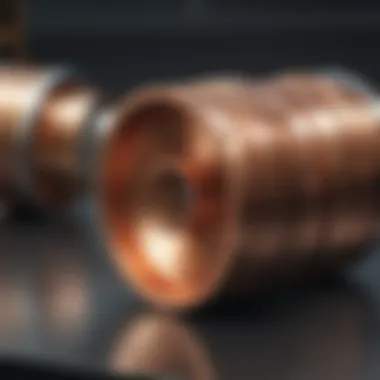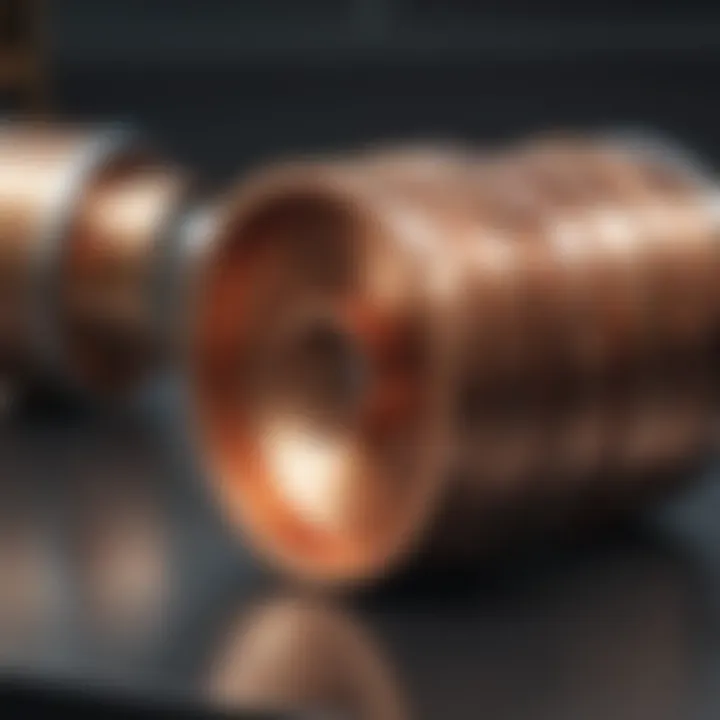Exploring the Versatility of Copper Tin Alloys


Intro
Copper tin alloys, often recognized through the term "bronze," represent significant materials in various industries, marking their importance in both historic and modern contexts. The intricate interactions between copper and tin not only establish unique properties that enhance material strength and corrosion resistance but also create solutions that have advanced technology over centuries.
This article seeks to provide a thorough exploration of these alloys, from their fundamental composition and properties to their applications in contemporary industries and the future trends they might follow. Furthermore, an understanding of their historical context will illuminate how copper tin alloys have shaped technological advancements.
Article Overview
Purpose of the Article
The primary aim of this article is to dissect copper tin alloys meticulously, spotlighting their composition, historical relevance, material characteristics, and manufacturing processes. Identifying their applications across numerous sectors, such as automotive, aerospace, and electronics, highlights their enduring significance in modern materials science. A critical examination of global market trends will be included, providing foresight into the potential developments in the utilization of these alloys in advanced technology.
Relevance to Multiple Disciplines
The discussion of copper tin alloys intersects various fields, including materials science, engineering, and industrial design. Each discipline can extract applicable knowledge regarding the properties and uses of these alloys, contributing to innovative advancements. Understanding the behavior of copper tin alloys is essential for students and professionals aiming to harness their characteristics in practical applications. This article aspires to integrate theoretical knowledge with practical insights, promoting a holistic understanding of these versatile materials.
Research Background
Historical Context
Copper tin alloys have a storied past, dating back thousands of years. They were first used in antiquity, with evidence of bronze tools and weapons discovered in ancient civilizations like those in Mesopotamia. The emergence of bronze heralded a significant leap in technology, leading to what is known as the Bronze Age, characterized by advancements in metallurgy that influenced societal development.
Understanding the timeline of copper tin alloy usage helps appreciate their evolution. From basic tools to complex aerospace components, the versatility of these materials underscores their historical impact.
Key Concepts and Definitions
To grasp the discussions surrounding copper tin alloys, several key concepts must be understood:
- Copper: A versatile, conductive metal known for its malleability and corrosion resistance.
- Tin: A softer metal that, when alloyed with copper, enhances strength and durability.
- Alloying: The process of combining two or more elements to create a material with desired properties.
These definitions set groundwork for the detailed examination of how the interplay between copper and tin leads to remarkable material characteristics.
"Bronze, as an alloy, revolutionized ancient technology and set the path for innovations that follow."
"Bronze, as an alloy, revolutionized ancient technology and set the path for innovations that follow."
In summary, this article will provide readers with a structured approach to understanding copper tin alloys, infusing rich detail and practical insights while maintaining clarity and accessibility. The following sections will delve deeper into the properties, creation processes, and contemporary significance of these alloys, ensuring an informative experience.
Foreword to Copper Tin Alloys
Copper tin alloys, most notably known as bronzes, play a crucial role in material sciences and numerous industrial applications. Their significance extends beyond mere functionality; they embody a rich historical context, representing one of the earliest alloying methods known to humanity. Understanding copper tin alloys is essential for several reasons. Firstly, their unique material properties make them suitable for various demanding applications, including machinery, electrical devices, and art.
Moreover, the study of copper tin alloys allows us to appreciate the advancements in metallurgy over centuries. From their primitive uses in ancient artifacts to their current applications in modern technology, these alloys illustrate the evolution of material science and engineering. By analyzing their composition and properties, we gain insights into how they can be tailored for specific uses, enhancing performance and longevity.
In this article, we will provide a thorough understanding of copper tin alloys, guiding readers through their definition, historical significance, and numerous applications. This exploration aims to not only inform about their practical use but also inspire new thoughts on their potential in future technological advancements.
Types of Copper Tin Alloys
Understanding the types of copper tin alloys is crucial for appreciating their characteristics and applications. The distinctions among different alloys inform manufacturing choices and the resulting material properties. Choosing the right alloy can significantly enhance product performance, making this topic both relevant and important.
Bronze Alloys
Bronze is perhaps the most recognized copper tin alloy. This material generally contains around 80% copper and 20% tin. However, the exact ratio can vary based on the specific application. Bronze is known for its excellent mechanical properties, including high strength and corrosion resistance. These characteristics make it suitable for a range of uses, from military applications to decorative arts.
Bronze can be categorized further into several sub-types:
- Phosphor Bronze: Contains a small amount of phosphorus, which enhances its strength and wear resistance. Ideal for electrical contacts and springs.
- Aluminum Bronze: This variant includes aluminum along with copper and tin. It offers superior corrosion resistance and strength, often used in marine applications.
- Gunmetal: Primarily used in casting, it has a high content of tin. This alloy is common in valve and pump components due to its excellent machinability and strength.
The versatility of bronze alloys allows them to meet demanding standards across diverse industries. Its historical significance also cannot be overlooked, as it was one of the first alloys used by ancient civilizations for tools and weapons.
Tin-Enhanced Copper Alloys


Another class of copper tin alloys includes tin-enhanced copper alloys. These typically feature a lower tin content, often below 10%. While they do not possess the same level of strength or corrosion resistance as bronze, they offer distinct benefits. Electrical conductivity is one such advantage. Copper alone is already a fantastic conductor, and adding tin can improve mechanical properties without significantly affecting electrical performance.
This category includes a variety of applications:
- Electrical Components: Tin enhances the performance of electrical connectors and wiring while maintaining excellent conductivity.
- Plumbing Fittings: Many plumbing applications utilize tin-enhanced copper alloys due to their resistance to corrosion and biofouling, ensuring long-lasting performance in wet environments.
In summary, the key to leveraging copper tin alloys lies in understanding their unique properties. Both bronze and tin-enhanced copper alloys offer specific benefits that cater to different needs in industry and technology. Their broad applicability underscores their importance in contemporary material science.
Chemical and Physical Properties
The chemical and physical properties of copper tin alloys are paramount to understanding their overall functionality and applicability in various sectors. These properties determine how these alloys respond in different environments, which is crucial for their selection in industrial applications. Comprehending these properties enables engineers and designers to make informed decisions about where and how to use these alloys effectively.
Mechanical Strength
One of the most notable attributes of copper tin alloys is their mechanical strength. These alloys exhibit enhanced strength compared to pure copper. The incorporation of tin improves the tensile strength and yield strength significantly. The mechanical properties are affected by the microstructure of the alloy, which can be manipulated during the manufacturing process. Depending on the tin content, copper tin alloys can achieve high levels of hardness, making them suitable for load-bearing applications.
For example, bronze, a well-known copper tin alloy, is used in applications ranging from bearings to marine components due to its excellent strength-to-weight ratio. The mechanical strength of these alloys also contributes to their durability, making them a favored choice in environments that demand resistance to wear and tear.
Corrosion Resistance
Corrosion resistance is another critical property of copper tin alloys, often determining their suitability for specific applications. The addition of tin enhances the corrosion resistance of copper, especially in moist or saline environments. Unlike pure copper, which can tarnish, copper tin alloys tend to develop a protective patina that resists further corrosion. This characteristic is particularly advantageous in plumbing, electrical applications, and marine settings, where exposure to water is common.
- According to studies, copper tin alloys can outperform other materials under certain conditions:
- Immunity to galvanic corrosion: When paired with dissimilar metals.
- Lifespan in corrosive environments: Reduces maintenance frequency and costs.
This makes copper tin alloys advantageous for long-term applications, as they are less likely to require frequent replacements or repairs.
Electrical Conductivity
The electrical conductivity of copper tin alloys is a crucial aspect for applications in the electrical and electronics sectors. Copper is already known for its excellent conductivity, but adding tin can modify its characteristics. Some alloys can maintain substantial electrical performance while benefiting from improved mechanical properties.
- Key Points on Electrical Conductivity:
- Many copper tin alloys exhibit conductivity that is still sufficiently high for electrical wiring and components.
- Certain compositions can provide a balance between conductivity and other beneficial properties, like strength and corrosion resistance.
In summary, while pure copper often reigns supreme in electrical conductivity, specific copper tin alloys offer favorable properties that allow for versatility in various applications.
Manufacturing Processes
The manufacturing processes of copper tin alloys are fundamental in defining their quality and applicability. Understanding these processes helps in optimizing the characteristics of the material for specific uses, ultimately impacting performance and longevity in real-world applications. Key elements include casting techniques, machining, and joining methods, each contributing distinctively to the final product.
Casting Techniques
Casting is one of the primary methods for creating copper tin alloys, allowing for intricate shapes and designs that would be challenging to achieve through other methods. The importance of casting lies in its versatility and ability to produce large quantities with consistent quality. Techniques such as sand casting, investment casting, and die casting are commonly employed.
- Sand Casting: This method involves creating a mold from a mixture of sand and a binder. Once the mold is formed, molten copper tin alloy is poured in. Upon cooling, the mold is broken away, revealing the product. This technique is suitable for large items and allows for quick production.
- Investment Casting: Also known as lost-wax casting, this method provides high precision and is ideal for detailed shapes. A wax pattern is coated with a ceramic material. After heating, the wax is melted away, and the alloy is poured in. This technique is more costly but results in excellent surface finish and dimensional accuracy.
- Die Casting: In die casting, molten metal is injected into a steel mold under high pressure. This process is efficient for mass production and offers tight tolerances and smooth surface finishes. It is particularly effective for smaller components and complex geometries.
Each casting technique has its own benefits and considerations, affecting factors such as cost, lead time, and final mechanical properties of the alloy. Selecting the right casting method directly influences not only the quality of the copper tin alloy but also its performance in applications.
Machining and Joining Methods
After casting, machining becomes essential for achieving the desired dimensions and surface finishes. Machining involves the removal of material through processes such as turning, milling, and grinding. It allows for precise shaping and fitting of components to ensure compatibility and performance.
- Turning and Milling: These methods involve rotating the workpiece against a cutting tool or vice versa. Turning is used to create cylindrical parts, while milling is effective for flat and complex surfaces. Both processes increase the accuracy of dimensions and enhance the physical properties of the alloy by removing surface irregularities.
- Grinding: This process is often used as a final finishing operation. It removes small amounts of material to achieve superior surface quality and precise dimensions.
Joining methods are equally important. Copper tin alloys can be joined using various techniques, including welding, brazing, and soldering. Each joining method carries its own advantages:
- Welding: This process involves fusing two pieces of metal together using heat. It creates a strong bond, ideal for structural applications.
- Brazing: Metal pieces are joined using a filler metal at a temperature below the melting point of the base metals. It is effective for thin-walled sections and dissimilar metals.
- Soldering: Similar to brazing but at lower temperatures, soldering is common in electronic applications.
Choosing the appropriate machining and joining methods ensures that the copper tin alloys maintain their essential properties while meeting specific engineering requirements. Throughout the manufacturing processes, it is crucial to uphold quality standards and mitigate defects, thereby enhancing the reliability and efficiency of copper tin alloys across various applications.


Applications of Copper Tin Alloys
Copper tin alloys, often recognized for their versatility, find significant applications across various sectors. Understanding the importance of these applications offers insights into why these alloys persist in relevancy. Their unique properties, combined with practical uses, illustrate how copper tin alloys support industrial innovation, enrich cultural artifacts, and adapt to technological advancements.
Industrial Uses
Copper tin alloys are prevalent in many industrial applications due to their excellent mechanical properties. These alloys typically exhibit high strength, durability, and resistance to wear, making them ideal for critical components in machinery and engineering.
- Automotive industry: They are often used in engine components such as bearings, bushings, and gears where durability is essential.
- Aerospace sector: The lightweight nature and strength of these alloys serve in making parts that require high reliability under extreme conditions.
- Construction: Copper tin alloys can also be found in plumbing fittings and electrical components, such as connectors and terminals, because they offer good corrosion resistance.
The alloy's thermal conductivity makes it suitable for heat exchangers and other equipment that disposes of energy efficiently.
Art and Cultural Significance
Historically, copper tin alloys hold cultural and artistic value. The earliest known use dates back to the Bronze Age, where various civilizations employed these alloys for crafting tools, weapons, and decorative items. Many ancient artifacts exemplify the aesthetic and functional qualities of these materials.
- Artifacts: Statues, coins, and instruments made from bronze, a prominent copper tin alloy, still hold substantial archaeological importance.
- Artistic expression: Artists utilize these alloys in sculptures and jewelry, taking advantage of their malleability and lustrous finish. Such uses reflect a blend of artistry and material science.
The significance extends beyond practical applications, as these alloys embody historical narratives and cultural identities.
Advancements in Technology
The evolution of technology continually influences the applications of copper tin alloys. Innovations in metallurgy and processing techniques enhance their performance, paving the way for new uses in advanced technology.
- Electronics: With increasing demands for lightweight and efficient materials, copper tin alloys are now common in electronic devices. They provide excellent conductivity and reliability in connectors and circuit boards.
- 3D Printing: Recent advances allow for the use of these alloys in 3D printing technologies, offering new avenues for manufacturing precision parts on demand.
Future research into these alloys may focus on optimizing compositions for specialized applications, yielding alloys tailored to specific industry needs.
"The unique attributes of copper tin alloys make them invaluable in both traditional and innovative applications, bridging historical significance with future potential."
"The unique attributes of copper tin alloys make them invaluable in both traditional and innovative applications, bridging historical significance with future potential."
Understanding these applications highlights their broad economic impacts and relevance in sustainability practices within material science. This analysis reveals that copper tin alloys are not merely relics of the past but pivotal elements driving industrial growth and cultural continuity.
Environmental Considerations
Environmental considerations are essential when discussing copper tin alloys, as these materials impact both production processes and broader ecological systems. The sourcing of raw materials and the effects of alloy production are key areas where environmental factors intertwine with industrial practices. Understanding these elements is crucial for sustainable practices in metallurgy and material science.
Sourcing of Raw Materials
The first step in producing copper tin alloys involves the extraction and sourcing of their fundamental components, copper and tin. These metals are sourced from mines, which can significantly influence local ecosystems. Copper is primarily extracted from sources like chalcopyrite, while tin is often sourced from cassiterite. The mining processes can lead to soil degradation, deforestation, and water source contamination. Because of this, the environmental impact of sourcing these raw materials necessitates careful consideration.
To mitigate adverse effects, companies increasingly employ environmentally responsible practices. Initiatives may include:
- Recycling: Utilizing recycled metals reduces the need for new mining. This practice not only conserves natural resources but also diminishes waste.
- Sustainable Mining: Adopting methods that minimize ecological disruption, such as limiting land usage and ensuring proper rehabilitation of mining sites.
These strategies highlight the industry’s movement towards responsibility in resource management while maintaining supply needs for copper tin alloys.
Impact of Alloy Production
The alloy production process also has substantial environmental implications. The methods used to produce copper tin alloys can contribute to air and water pollution. For instance, smelting processes emit greenhouse gases and particulates into the atmosphere, leading to air quality deterioration.
Furthermore, production facilities may generate effluents containing heavy metals. If not managed correctly, these effluents can infiltrate local water systems, posing risks to marine life and human health. To address these challenges, the following practices are worth noting:
- Emission Controls: Implementing technologies that reduce emissions can significantly lower the environmental footprint of production.
- Waste Management: Efficient systems for managing waste can prevent harmful materials from entering ecosystems.
"Sustainability is not just a goal; it is a starting point. The way forward is to develop processes that not only create materials we need but also respect the planet."
"Sustainability is not just a goal; it is a starting point. The way forward is to develop processes that not only create materials we need but also respect the planet."
Ensuring sustainable production of copper tin alloys is vital for their long-term viability in the market. Companies that prioritize these environmental considerations are likely to position themselves favorably in an increasingly eco-conscious world.


By examining both the sourcing of raw materials and the impacts of alloy production, we can better understand the path toward more sustainable practices in metallurgy.
Market Trends and Economics
The market dynamics surrounding copper tin alloys play a crucial role in industries that rely on these materials. Understanding the trends and economic factors can lead to more informed decisions for manufacturers and researchers alike. This section will explore the significance of global demand and supply while emphasizing the investment in copper tin alloy research.
Global Demand and Supply
The demand for copper tin alloys is closely tied to various sectors, including construction, electronics, and automotive industries. These alloys are prized for their strength and resistance to corrosion.
- Construction: Copper tin alloys are often used in various structural applications due to their durability and aesthetics.
- Electronics: With the continuous advancement of technology, demand for high-performance alloys in electronic components increases.
- Automotive: As manufacturers push for lighter and stronger materials, copper tin alloys provide a balance of weight and performance.
The global supply chain for these materials faces challenges, including fluctuations in copper and tin prices, geopolitical influences, and environmental legislation. Producers must navigate these hurdles to maintain production efficiency and meet market needs. Additionally, any disruption in mining operations or labor disputes can intensify supply issues and affect pricing trends.
Investment in Copper Tin Alloy Research
Investment in research related to copper tin alloys has seen a notable increase in recent years. Companies and institutions recognize the necessity for innovation to enhance alloy properties, leading to more efficient production processes and applications.
- Improving Alloys: Ongoing research focuses on developing alloys that can withstand higher stresses and temperatures. This is vital for the aerospace and automotive sectors, where safety and performance are paramount.
- Sustainability: Sustainable production techniques are becoming increasingly important. Research is directed towards reducing the environmental impact of alloy manufacturing.
- Technological Advancements: New methods of synthesis and processing are on the rise, leading to enhanced material performance and reduced costs.
"Investing in research not only drives innovation but also positions companies to adapt to market changes effectively."
"Investing in research not only drives innovation but also positions companies to adapt to market changes effectively."
Future Directions and Research Opportunities
The evolving landscape of materials science has brought copper tin alloys to the forefront of research and development. As industries seek materials that are not only functional but also sustainable, the examination of future directions in copper tin alloy research becomes increasingly crucial. New applications and innovations promise to redefine their use and enhance their properties while responding to global challenges.
Innovations in Alloy Design
Recent advancements in alloy design focus on the enhancement of properties such as strength, durability, and corrosion resistance. Researchers are now utilizing advanced computational models to predict the behavior of these alloys under various conditions. By using techniques such as molecular dynamics and density functional theory, scientists can tailor the composition of copper tin alloys more precisely than ever before.
For example, the introduction of additional elements, such as aluminum or nickel, can significantly improve mechanical properties. Studies have shown that these modifications often yield better performance in high-stress environments, enhancing the application range for industries such as aerospace and automotive.
Furthermore, innovative production techniques, including additive manufacturing and rapid prototyping, allow for the creation of complex geometries that were previously unachievable with traditional methods. This flexibility in design is indicative of a shift toward more specialized and efficient uses of copper tin alloys, catering to the specific needs of advanced applications.
Sustainability Initiatives
As awareness of environmental issues grows, the push for sustainable practices in metallurgy becomes imperative. The development of copper tin alloys is now being closely aligned with sustainability initiatives. These efforts focus on several key areas:
- Recyclability: Copper and tin are both inherently recyclable, which enhances the sustainability of these alloys. The use of recycled materials not only lowers production costs but also reduces the overall environmental footprint.
- Energy Efficiency: New processes are being developed to minimize energy consumption during the production of copper tin alloys. Techniques such as refining recycling methods and reducing the need for high-temperature processing can significantly cut down on energy use.
- Life Cycle Assessment: Conducting life cycle assessments for copper tin alloys helps identify opportunities to reduce waste and improve efficiency throughout their entire lifecycle, from sourcing materials to final disposal.
Incorporating sustainability into alloy production is not just a trend; it is becoming a necessary foundation for future development. Companies that invest in these initiatives are more likely to succeed in a market increasingly driven by eco-friendly practices.
"The future of copper tin alloys will not only be defined by their material properties but also by their contributions to a sustainable and circular economy."
"The future of copper tin alloys will not only be defined by their material properties but also by their contributions to a sustainable and circular economy."
These future directions underscore the importance of continuous innovation and research in the field of copper tin alloys. The intersection of advanced material design and sustainability creates new opportunities for applications that can meet the demands of modern society.
Ending
The conclusion of this article serves as a crucial recap of the intricate relationship between copper tin alloys and their multifaceted applications, properties, and trends. Understanding this field offers numerous practical benefits for industries ranging from manufacturing to art, as these alloys exhibit excellent mechanical strength and corrosion resistance. Furthermore, the exploration into environmental considerations underlines the importance of sustainable practices in sourcing and processing these materials, emphasizing the necessity for industry accountability.
Another essential element to consider is the role copper tin alloys will play in upcoming technological advancements. As research progresses, these materials are expected to be at the forefront of innovations in various sectors. This article has highlighted how ongoing investment and interest in alloy research will potentially lead to improved properties, optimized manufacturing processes, and wider usability.
By synthesizing the information discussed throughout the article, it becomes evident that copper tin alloys are not just a historical curiosity. Their continued relevance and versatility serve as a testament to their significant place in materials science, pushing boundaries and making them indispensable in modern applications.
Summary of Key Points
- Definition and Composition: Copper tin alloys include a variety of formulations, primarily consisting of copper and tin, with other elements potentially added to enhance specific characteristics.
- Historical Context: The development of these alloys has evolved over centuries, impacting ancient and modern societies alike.
- Mechanical Strength: These alloys present impressive strength characteristics, suitable for a range of mechanical applications.
- Corrosion Resistance: Their natural resistance to corrosion makes them ideal for use in harsh environments.
- Market Dynamics: Current trends indicate a growing demand for copper tin alloys across multiple sectors, fueled by technological advancements and sustainability considerations.
Potential for Future Use
The future prospects for copper tin alloys look promising. Innovations in alloy design could lead to new formulations that combine even higher durability with lower environmental impacts. For example, integrating other metals or elements into the alloy mix may yield specific properties suitable for niche applications.
Additionally, the emphasis on sustainability initiatives will likely drive the development of processes that minimize waste and enhance recycling capabilities. This aligns well with global trends favoring sustainable materials and practices in industries.



